Intel Z77 Motherboard Review with Ivy Bridge - ASRock, ASUS, Gigabyte, and MSI
by Ian Cutress on May 7, 2012 7:40 PM EST- Posted in
- Motherboards
- MSI
- Gigabyte
- ASRock
- Asus
- Ivy Bridge
- Z77
Power Consumption
Power consumption was tested on the system as a whole with a wall meter connected to the OCZ 1250W power supply, while in a dual 7970 GPU configuration. This power supply is Gold rated, and as I am in the UK on a 230-240 V supply, leads to ~75% efficiency > 50W, and 90%+ efficiency at 250W, which is suitable for both idle and multi-GPU loading. This method of power reading allows us to compare the power management of the UEFI and the board to supply components with power under load, and includes typical PSU losses due to efficiency. These are the real world values that consumers may expect from a typical system (minus the monitor) using this motherboard.
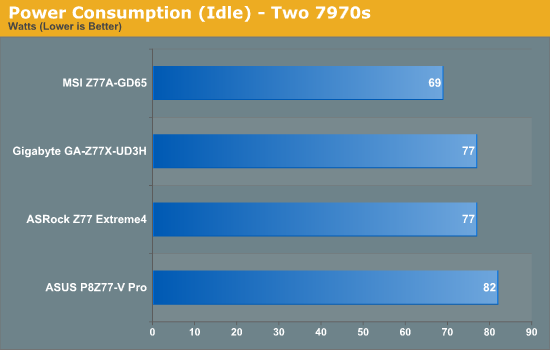
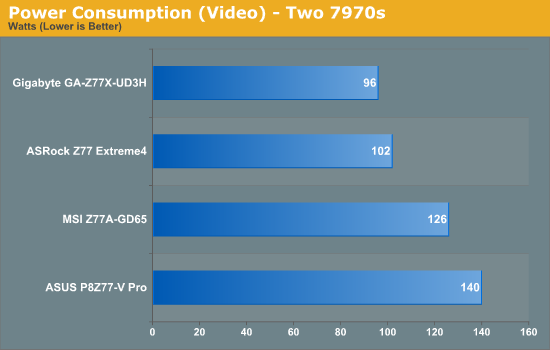
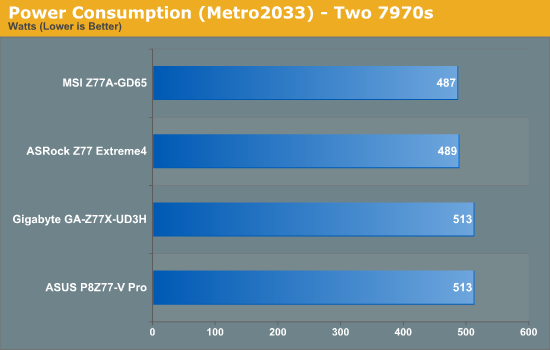
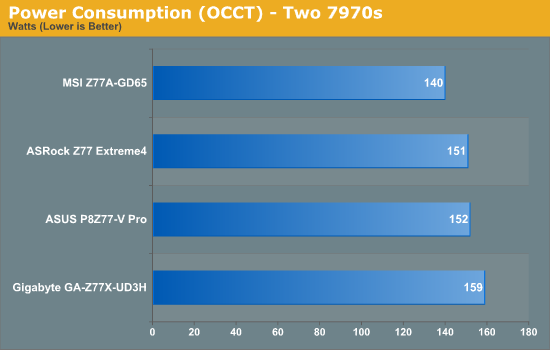
Perhaps the alarming graph of these is the power draw under video performance. It seems that certain motherboard BIOSes consider it a more intensive task, waking up more of the processor (or GPU) to compensate. At load however, we see the MSI and the ASRock boards drawing less power overall.
Boot Times
Different motherboards have different POST sequences before an operating system is initialized. A lot of this is dependent on the board itself, and POST boot time is determined by the controllers on board (and the sequence of how those extras are organized). As part of our testing, we are now going to look at the POST Boot Time - this is the time from pressing the ON button on the computer to when Windows starts loading. (We discount Windows loading as it is highly variable given Windows specific features.) These results are subject to human error, so please allow +/- 1 second in these results.
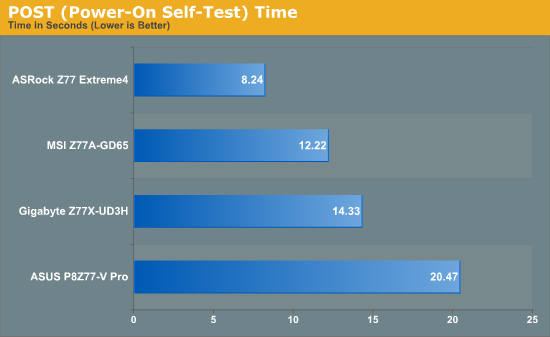
With a lot more controllers to initialise on board, the ASUS P8Z77-V Pro requires at default 20.47 seconds to reach the windows loading screen. By disabling controllers that aren't used, a time more like the ASRock could be achieved. There is direct correlation between functionality and POST time.
Overclocking
Here at AnandTech we want to provide quick and easy ways to determine if a board is good for you (with in-depth analysis of course). So here is a quick round up of our overclocking results. Overclocks are tested for stability with PovRay and OCCT - while these may not be the most strenuous of stability tests, it does offer a quick check for memory errors under high load (and also balances testing time with getting the next board on for review!).
|
CPU Speed (MHz) |
Voltage (Volts) |
PovRay Peak Temp (ºC) |
OCCT Peak Temp (ºC) |
Notes | |
|
ASRock Z77 Extreme4 |
4700 | 1.175 | 86 | 86 | LLC Level 1 |
|
ASUS P8Z77-V Pro |
4700 | 1.200 | 83 | 86 | PLL Overvoltage enabled |
|
Gigabyte Z77X-UD3H |
4700 | 1.200 | 82 | 86 | LLC Extreme |
|
MSI Z77A-GD65 |
4700 | 1.250 | 90 | - | PLL Overvoltage enabled |










117 Comments
View All Comments
vegemeister - Thursday, May 10, 2012 - link
Yes, it is a very important feature. The Ivy Bridge IGP can drive 3 monitors. 4 display outputs means 3 of them are digital.Discrete GPUs increase idle power consumption, an as of this post none of them have particularly good open source drivers. Some of us just want lots of screens, good compiz performance, and silence.
philipma1957 - Monday, May 7, 2012 - link
I have been building a series of matx htpc/gamer machines.I have one with the basic
Gigabyte GA-B75M-D3H mATX board
and one with the
Gigabyte Ga-h77m-d3h mATX board.
I want to decide between
the ASUS P8Z77- m pro mobo or
the ASUS p8z77-m board and
last but not least the
Gigabyte Intel Z77 LGA 1155 AMD CrossFireX/NVIDIA SLI DVI/HDMI/DisplayPort Dual UEFI BIOS mATX Motherboard G1.SNIPER M3 .
I am liking the two builds I did with the lowend gigabyte boards and some intel i5 t2500t cpus I want a better board but I don't have many reviews to go by.
EnzoFX - Monday, May 7, 2012 - link
It just doesn't make a whole lot of sense to me. Are most DIY'ers really opting for ATX? Should they? I'd bet most people only plug in a video card and maybe one other card such as wireless or even a tuner. Every other possible need they may have would not only be met by mATX but even ITX is pretty full featured these days.You'd think mATX would be what most boards are targeted at, and leaving ATX for extreme builds/bragging rights. It's just like those high end video cards, most people don't buy those, rightfully and importantly so. Those should be the premium prices, and mATX should have a lower price. The focus just feels off.
Zoomer - Monday, May 14, 2012 - link
You mentioned people want mATX board. There by itself probably means that it can command higher prices, due to higher price tolerance of the purchasers.Caeric - Monday, May 7, 2012 - link
Enjoyed the review. I still have an old AMD dual core, and I'm considering a new system in the next couple of months so these help a great deal.I did find one error in the article, under the ASUS board:
"The ASUS P8Z77-V Pro retails at $225-$235, essentially $100 less than the ASRock Z77 Extreme4..."
It should say "...essentially $100 more than the ASRock..."
Movieman420 - Monday, May 7, 2012 - link
Curious as to this controllers' performance vs the ever present Marvell controllers. Does it use a pci-e lane or usb3 for it's bandwidth?FozzyofAus - Monday, May 7, 2012 - link
Great review.I'm leaning towards mATX as well for this build as I've never used more than four expansion slots and currently I'm only using 3 (one is USB3 which won't be needed in the new board).
I'd like to have a bit more room in my current case and the option to reuse this motherboard in a smaller case in future if I upgrade my main rig to Haswell next year.
Any chance of adding Asrock Extreme4-m to the next motherboard roundup?
spronkey - Monday, May 7, 2012 - link
Sorry guys but this review was a bit average. Comment on the various different controllers used by the motherboard manufacturers but don't offer any kind of review on them?The good additions: DPC latency and boot time.
The missing? Well everything else.
I was especially hoping for a comment on the VIA audio on the UD3H - it's been a while since I've seen VIA codecs on mainstream boards.
I'm also amazed that you didn't slam the ASUS board for it's price and lack of features. Realtek 892? On a board that's nearing twice the cost of the ASRock? Seriously?
No comment on the durability of the boards either? Hrm. No separation in testing of the different controllers on each board?
A bit lacking, sorry.
ggathagan - Thursday, May 10, 2012 - link
Perhaps you're commenting on the wrong review.As Ian stated multiple times throughout the review, Asus is using Intel NIC's on their boards, in this case, the Intel 82579V.
Durability is a function of time. Please point out the other motherboard reviews that covered durability.
spronkey - Thursday, May 10, 2012 - link
He stated ASUS were using Intel, sure. But didn't get into any details other than stating they exist about the fact that there are multiple USB3 controllers and SATA controllers on each board. No benchmarks comparing them etc.In fact does it even mention which controllers were tested?
And Durability is a function of construction quality and time. It would be nice to see comments on points such as board weight and flex, quality of soldering, quality of components used on the board (according to an electrical minded person on OCN, Gigabyte uses significantly higher rated MOSFETs than other manufacturers), temperatures of chipsets and VRM circuitry. These are things I can't easily find out by reading manuals.